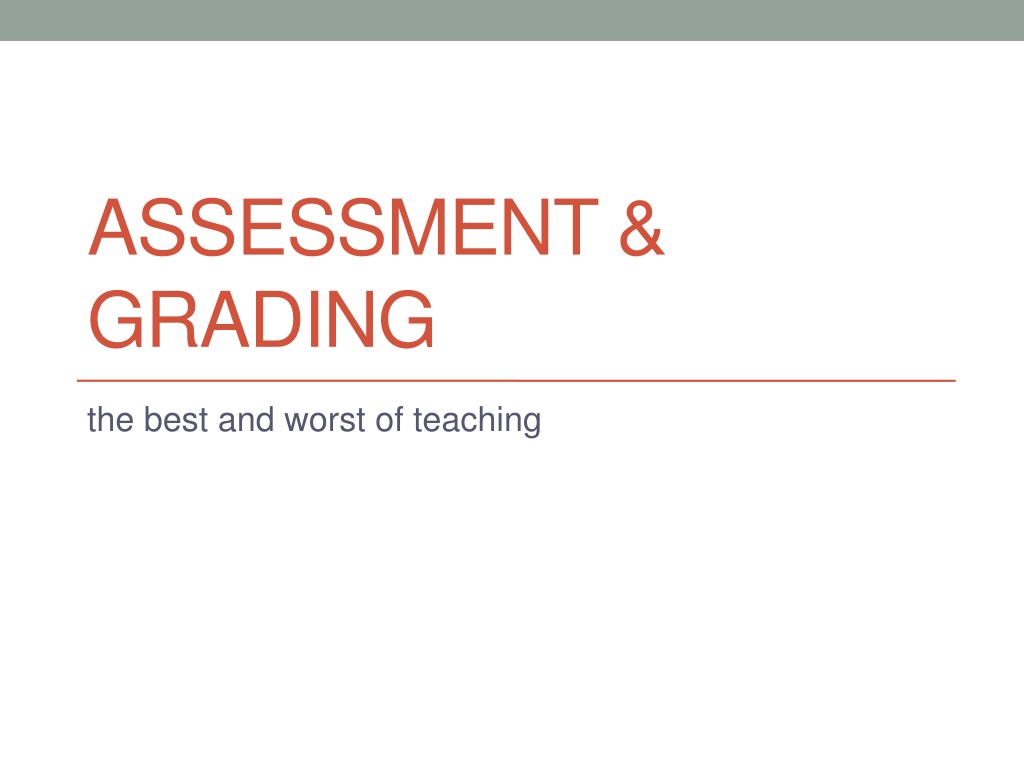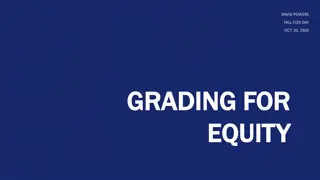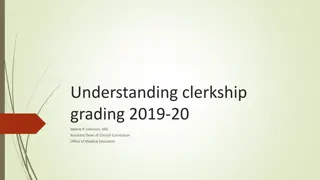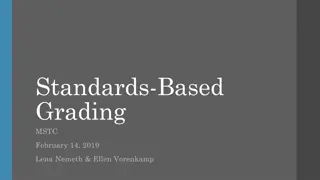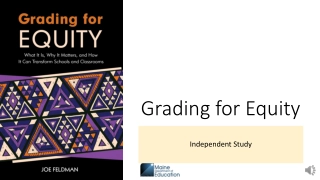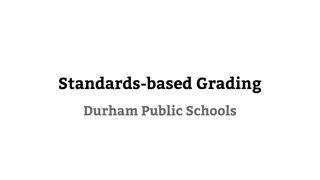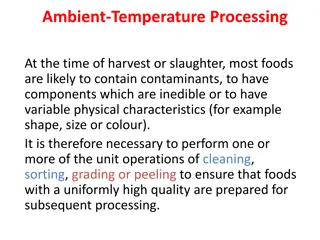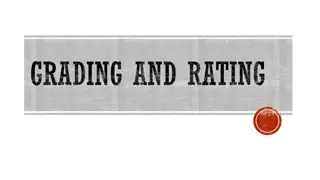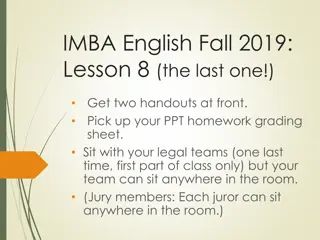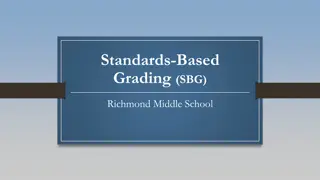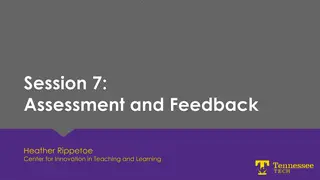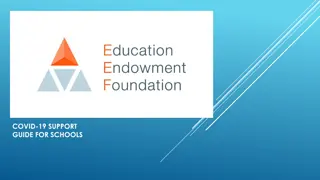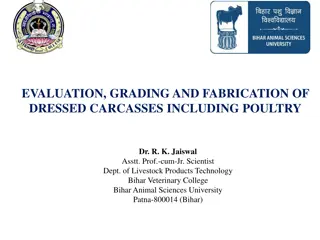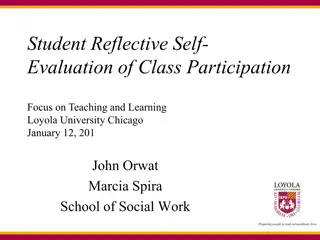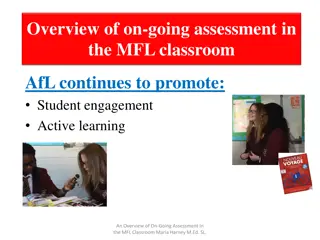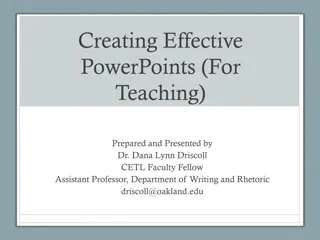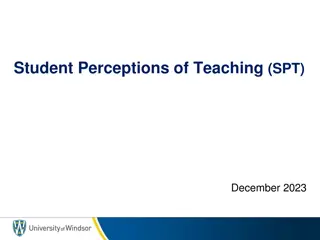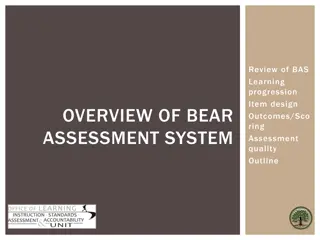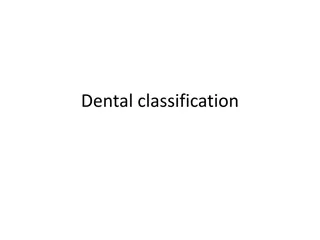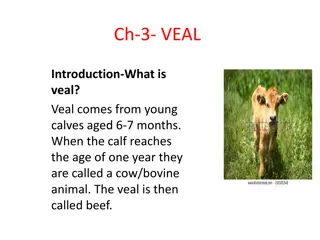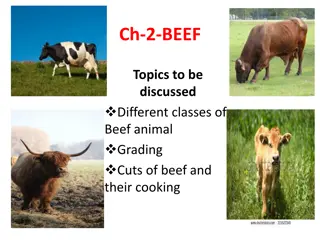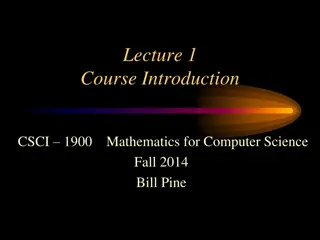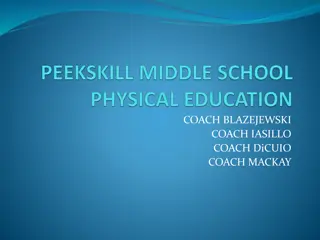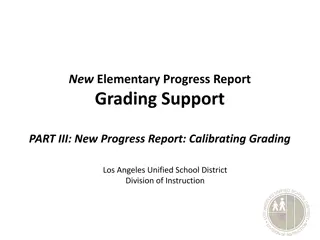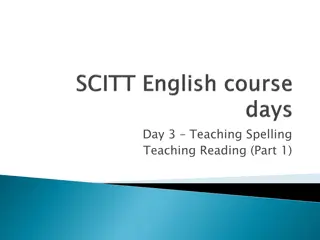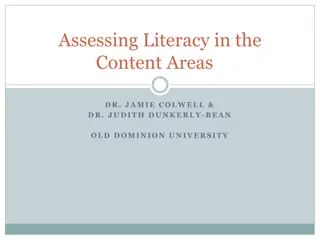Effective Strategies for Teaching Assessment and Grading
Explore key aspects of assessment and grading in teaching, including organization, instructional objectives, types of assessments, writing assessment tasks, managing borderline grades, and offering extra credit. Learn to create authentic assessments, avoid biases, and maintain consistency to enhance student learning outcomes.
Uploaded on Sep 19, 2024 | 0 Views
Download Presentation

Please find below an Image/Link to download the presentation.
The content on the website is provided AS IS for your information and personal use only. It may not be sold, licensed, or shared on other websites without obtaining consent from the author. Download presentation by click this link. If you encounter any issues during the download, it is possible that the publisher has removed the file from their server.
E N D
Presentation Transcript
ASSESSMENT & GRADING the best and worst of teaching
the organization Planning Instruction Assessment
Instructional objectives for yourself and your students help keep organization and focus make sure they are observable, measureable and outcome-directed
types of assessment informal question-asking observations formal types: homework, exams, attendance, quizzes, essays, performance assessments remember that assessment is about distinguishing between those who know and those who do not. Don t confuse with those who are good test-takers, make it look good, etc.
writing assessment tasks ALWAYS write then walk away. Gives you fresh eyes performance assessments: make as authentic as is feasible; focus on skill-attainment/demonstration; design (and share, if comfortable) good scoring; make sure you have the time for design, administration, and scoring; tend to lend themselves to higher-order skills essay-type assessments: allow you to assess writing/communication skills in addition to knowledge; nice for allowing variations in responses, but trickier for scoring; tend to lend themselves to higher-order skills traditional exam-type assessments: clarity!; format to maximize efficient and effective responding; look carefully for unintentional cues
borderline grades do they exist in your class? if so, what is borderline? (.5%? 2%? may or may not want to include cut-off in syllabus) identify what you use to assign the higher grade most assignments in the class are at that grade level effort-based components (all assignments in on time, attendance, participation) beware of being influenced by personality/negotiation factors or characteristics that you really can t measure (effort, potential)- unfair! apply borderline grade changes consistently realize that borderline situations can increase and decrease student grades if done fairly
extra credit check department and other instructors policies make available to all students consider how the extra credit affects final grade- usually do not want to raise all grades one letter effort- or ability-based? keep as a separate column in gradebook so you can separate ability from other factors
zeroes consider effect of the zero on the final grade reasons for the zero poor quality versus non-submission factors that led to the zero policies on late work alternatives give partial credit (late penalty, half credit substitution) calculate the final grade without that assignment provide different assignment allow all students to drop or replace a low grade
types of scoring checklists distinguishes done from not done best when you have a specific list of tasks within the assignment can be worth multiple points, but should be used for all-or-none credit e.g., Paper was double-spaced Included example of concept rating scales generally 3-5 categories more than yes/no, but not so many categories to be fine distinctions use parallel descriptors avoid average can assign point values to descriptors like checklist, breaks the assignment into specific tasks, but includes quality markers e.g., Concept description was detailed. Excellent-Good-Fair-Poor- Not Done
analytic rubrics like the ratings scale, but each point value has a specific description e.g., 5 points=fully explained description that links to theory. 4 points= somewhat vague description. 3 points= missed a theory link... holistic rubrics grade overall assignment with a single grade still have descriptors for grade/point assignments used when cannot be easily broken into tasks or allowing A LOT of freedom in responses generally fastest scoring to use, but tough to justify and tends to be less reliable e.g., 10 points= presentation was complete and accurate. 9 points= presentation well done, but could have used more evidence
checklist example Checklist (all-or-none) Assignment uses the designated chart At least 3 Bloom s are analysis or higher PA indicated ____ (+2) ____ (+2) ____ (+1)
ratings scale example points 4 3 2 1 0 PA/task choice PA/task covers the instructional objectives and standards indicated. PA/task design allows students to demonstrate mastery of content. Expert Apprentice Beginner Novice Not done Excellent Good Fair Poor Not done
analytic rubric 4 Habit description Behavior description clear, behavior measureable 3 2 1 0 Description Description mildly vague or somewhat not measureable Mildly vague description, or not all precede, or vague (dis)associat e Description very vague or not measureable Description very vague and not measureable Not described Clear description, precede behavior, how (dis)associat e Very vague or none precede or no (dis)associat e Cannot assess those identified as stimuli No identified stimuli or misidentified as stimuli Stimuli description Daily log Behaviors each day Plan when fail 5 days 4 days 2-3 days 1 day No behaviors described No changes described for all failures All changes described or no failures Missing changes for at least 1 fail
holistic rubric 10 points = The report is well-organized, complete, and reported in a unique fashion. 8 points = The report needs more detail or organization. 6 points = Good content, but format was not unique 4 points = Report needs major changes. 2 points = Report is incomplete or poorly executed
student atten part ex1 hw1 pres ex2 paper final excr total % 10 pts 20 40 50 25 40 85 75 (5) 335 Brady, Marcia Bundy, Al 10 17 24 48 21 32 79 66 3 300 89.6% 10 18 30 48 24 33 72 28 5 268 80.0% Halpert, Pam Jefferson , George Simpson, Lisa Stark, Ned White, Walter averages 4 14 20 27 15 29 70 52 2 233 69.9% 9 0 28 49 25 38 82 71 0 302 90.1% 7 17 18 26 16 30 80 68 4 266 79.7% 10 20 32 0 25 40 85 75 5 292 87.2% 4 7 28 47 24 39 79 72 0 300 89.6% 7.7 13.4 25.9 35.1 21.7 34.4 78.3 61.9 (2.7) 281.1 84.0%
process of grading optimize self and environment have time, not tired or cranky (tough when facing a stack!) minimize distractions (friends, significant others, kids, Facebook) more subjective tasks usually require more time and concentration try to keep student identities unknown as you grade to avoid biases if grading both, grade mechanics (grammar, spelling) first, then content aim for two positive comments for each improvement comment- think of grading as a conversation between you and the student, not a punishment read through a few assignments before grading to get a sense of content and quality make comments on a separate page (or version if electronic) and go back occasionally to see if you are grading the same as you had initially if others are also grading the assignment, have everyone grade a few to ensure consistency for selected-response items, grade one page at a time to give yourself a sense of how well items are working for multiple constructed-response items, grade one at a time for all students (e.g., grade everyone s item 27, then everyone s 28 ) for greater consistency
